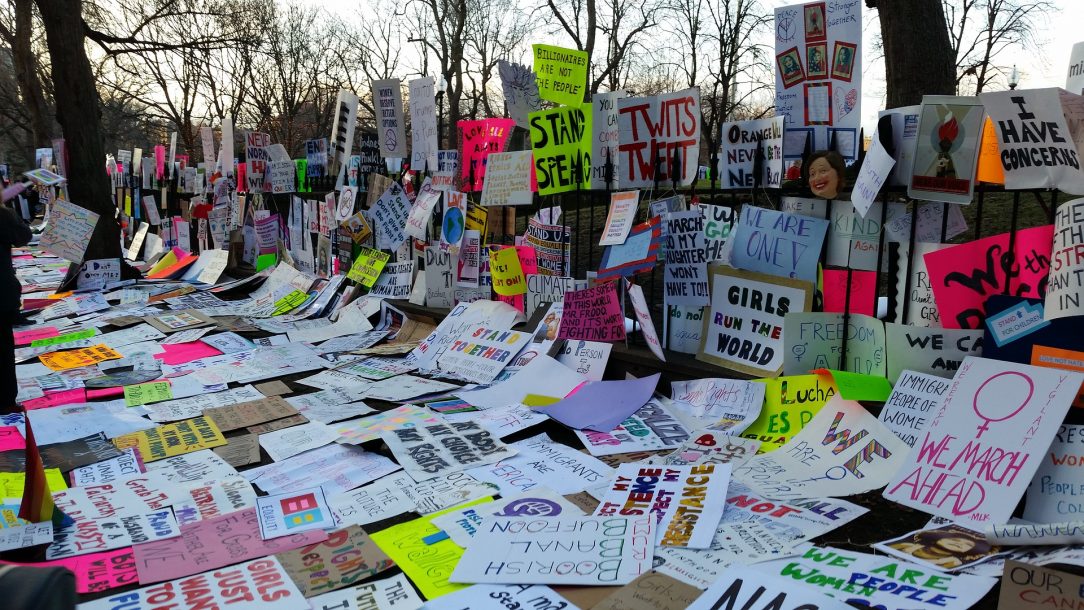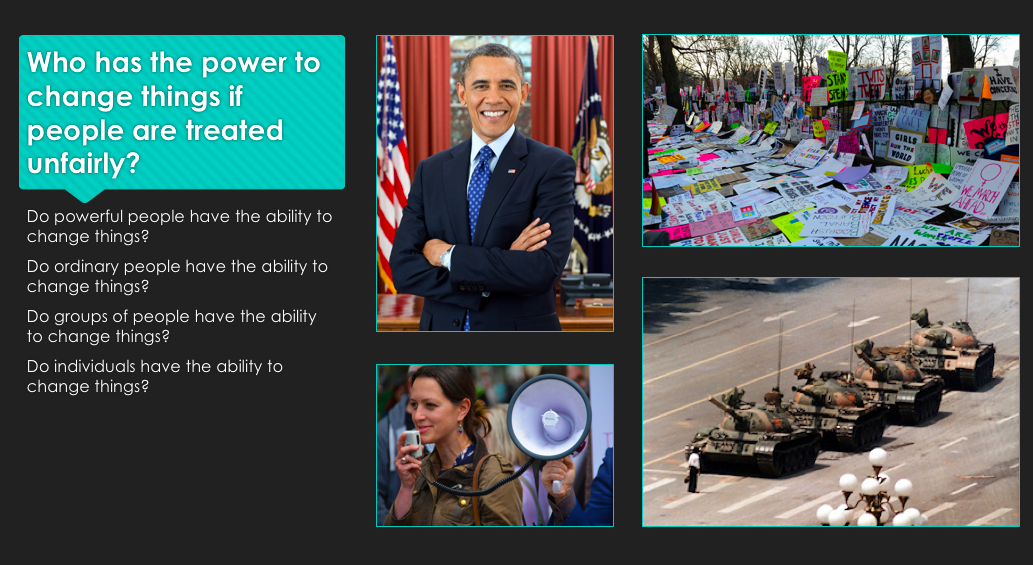
Three Essential Questions About Equality For You Social Studies Class
It’s no secret that the general public is pretty ignorant about the political process. There are any number of data points that you can cite to show what people don’t know.
And one of the reasons for this is that at times we aren’t fulfilling our purpose with social studies classes. They are often structured as history courses dominated by facts and chronology. We should instead be structuring our curricula around a set of important themes and essential questions that illustrate various things about society.
If we did this, we could take a lot of those facts that people memorize and turn them into tools by which we can understand the world around us. This is learning to read the word in order to read the world – instead of for its own sake.
If it were up to me, social studies would be entirely thematic and we’d forget all about chronology. It’s more important to talk about the important questions – and bring content to bear on those questions – than it is to cover every time period in history. But we don’t all have that luxury.
An alternative is to preserve that chronology but use essential questions and themes to help us decide what to emphasize and what to teach. Those themes can bridge the gap between time periods and connect otherwise disparate pieces of content.
Today, we’ll look at one of those important themes: Equality and Social Change. I’ll share a set of essential questions about equality that I use with my own students along with a powerpoint that I use to facilitate a discussion in class. Stay with me to the end of this post, and I’ll share some resources on other important themes as well.
For a complete list of essential questions on the five themes, go back to the main post.
Three Social Studies Essential Questions Related to Equality
At the beginning of every year, I start out by discussing a set of essential questions. That includes three questions that relate to equality. By doing this, I can get a sense of what my students think as they are coming into my class and I can get my kids thinking about some big ideas that we’ll return to throughout the course.
I made a slideshow with the three questions, some follow up prompts, and some relevant images to help move the conversation along. I’ll go through each of the questions below, and discuss why it’s important and some of the things that’ll come up in your class discussions.

If you want to download a copy of the powerpoint, just enter your e-mail below. I’ll send you a link to download this Power Point, as well as other resources that you can use to incorporate these essential questions into your class.
Here are three of the essential questions about equality that I used for this.
Are All Americans Treated Equally?
On the face of it, of course all Americans are equal. It says so right in the Declaration of Independence – “We hold these truths to be self-evident: that all men are created equal.”
But of course the story of American history is the story of exceptions to that rule. This question is a wonderful one to think about how American society has changed over time and how it has come increasingly closer to living up to that initial promise.
The answer to this will of course change over time. In the early days of America, very few people enjoyed the idea of being equal before the law. But over time economic distinctions disappeared and immigrant groups were brought into the fold. Eventually women rise to an equal place as well and legal forms of discrimination end.
But on the other hand, there are de facto forms of inequality that persist – whether it’s wage inequality, institutional racism, or the extant legal discrimination against youth, felons, and non-citizens. Is there really a good reason why sixteen year olds can’t vote? Once upon a time, you had to be twenty one or twenty five, and we eventually changed that.
Who Has the Power to Change This?
In each period in American history, there are people who challenge the status quo. There are the great individuals and heroes – from Patrick Henry to Ida B. Wells to Malcolm X. When I ask my students to name someone who changed society they often name Dr. Martin Luther King, Jr. or Rosa Parks.
But there are also organizations that drive movements, like the League of Women Voters and the NAACP. And then there are the ordinary folks who play their part in marches, protests, and strikes along the way.
This question can be a really powerful one for students to think about because it’s natural to think that change comes from the first group – the individuals and heroes. But behind each of them, you’ll often find an organization full of regular people who provide the support and strength to create social change.
By focusing on this and interrogating the role that ordinary people play in creating social change, you can help build the political efficacy of your students. If they think that change comes from heroes, then there’s no reason for them to do anything. But if change comes from people – well they’d better stand up and get involved.
And at the core of it, political efficacy – the idea that you can make a difference – is the most important driver of civic engagement.
How Do People Change This?
It’s also worth thinking about how people bring about this change.
The examples my students usually provide are things like the Montgomery Bus Boycott and the protests and sit-ins of the civil rights movement.
But in history there are also violent revolutions, like those in the United States, France, and Haiti. There are “bloodless” revolutions, too, like the Glorious Revolution in England.
There are street protests and movements, like the women’s suffrage movement or the civil rights movement. Boycotts have proven effective at times, along with sit-ins and various types of strikes.
In the old, traditional version of American history, change came through presidents and government and laws. But when you start to look at the real drivers of change you can appreciate the various techniques that they used throughout history. And in every period of history you have examples of people trying to change the status quo and it’s worth examining how it is they go about achieving that change.
How Do These Essential Questions About Equality Fit Into Your Class?
You’ll have to decide that for yourself, but here’s some insight into how I use them.
This is always one of my introductory classes at the beginning of the year. I spend the first two weeks or so establishing class expectations and discussing essential questions. On one of those days, we’ll discuss these questions about equality and social change.
This is a great opportunity to start with an A/B writing – either “Americans are all equal” or “Americans are not all equal.” From there, we can discuss the first question and how people are treated more or less equally over time. Then we segue into how people change things when there is inequality, and inevitably students end up telling me about Rosa Parks and the Montgomery Bus Boycott.
I end that lesson with a quick writing assignment for homework. I ask them to pick an example of someone who tried to change society, describe what they did, and evaluate whether or not they were successful.
After that first day, I use these essential questions to anchor the curriculum moving forward. As we learn about each unit, we’ll reflect on the questions again and answer them in light of what we’ve learned. Did this unit change our understand of whether people are treated equally? Did this unit give us more examples of people who tried to change things or of ways that they did so? This is a great recurring form of assessment, and it helps create connections between different units and time periods.
And if you want to download a copy of the powerpoint for your own use, don’t forget to go back up and use the share button. That will unlock the file so you can access it directly.
More About Essential Questions and Thematic Curricula
Equality is one of five themes that I focus on throughout my course. Take a look at this post for a complete set of essential questions about those five themes.
You ought to check out Dr. Beth Rubin’s book, Making Citizens: Transforming Civic Learning for Diverse Social Studies Classrooms. I learned a lot from it on how to integrate themes and essential questions into my course, and it’s an excellent read if you want to dig into this stuff more. This blog post also offers some ideas about the topic.
Have you used these questions with your students? How did the conversations go?